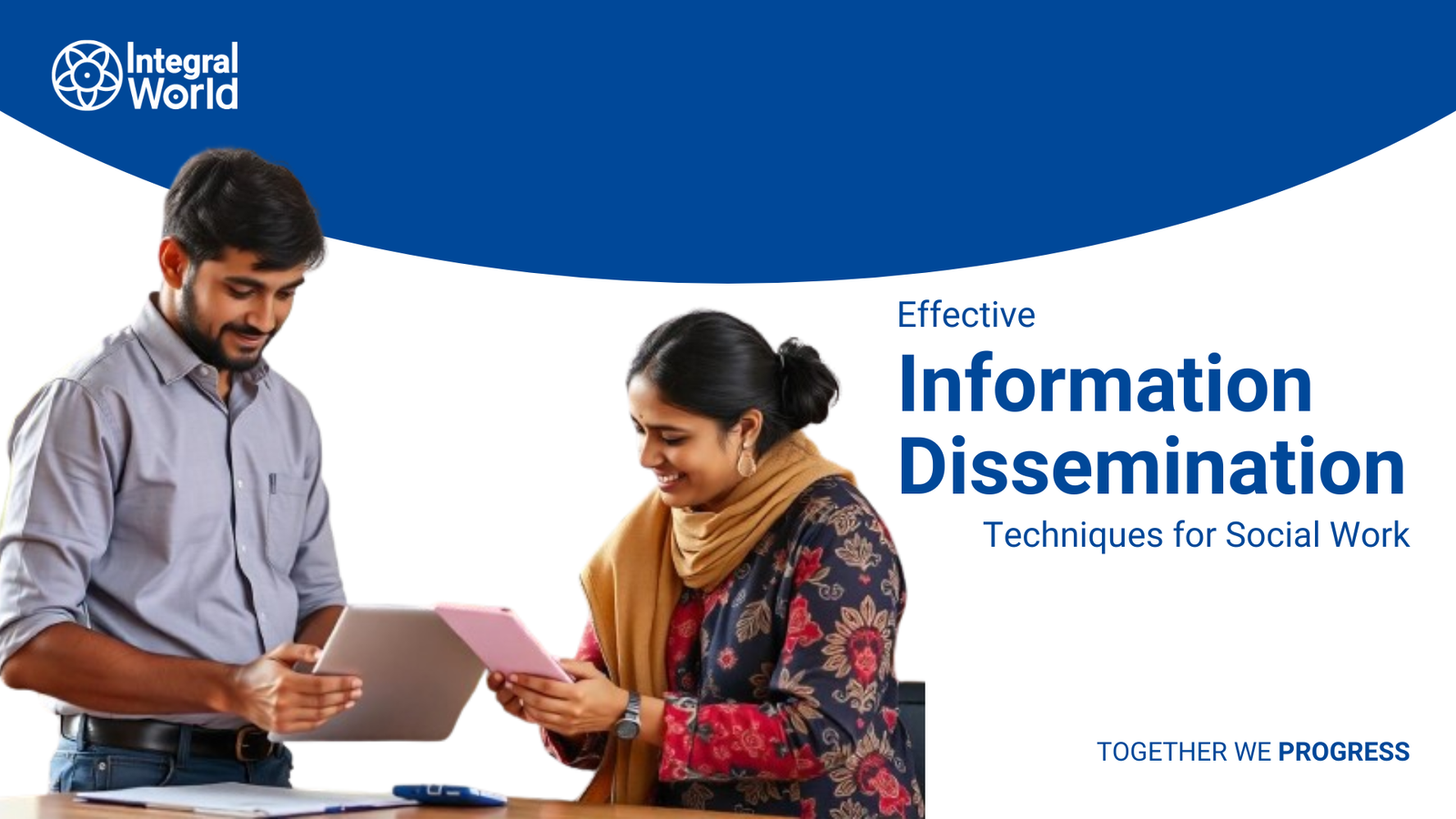Genuine communication establishes trust, enhances the credibility of a person or an entity and ultimately leads to greater impact and success. This article explores effective information dissemination techniques for social work that centres on authenticity. We will look at real examples from organisations that have thrived using authentic practices, offer tips on how to be authentic and discuss leadership’s role in cultivating an authentic organisation culture. Stick with us as we make Integral World the authority in steering non-profits towards genuine and effective communication.
The Power of Authenticity in Non-Profits
Authenticity in this context means being real, open and consistent through all channels of communication. It implies that organisations should align their values, mission and actions with their messaging so as to build trust among donors, beneficiaries and the wider community.
Tips for Maintaining Authenticity in NGOs
Being transparent requires time and effort plus a commitment to open practices. Below are some practical tips for NGOs:
1. Transparent Reporting
Updating stakeholders about your projects regularly is very important including financial reports, project updates, performance indicators among others which should be honest enough showing both successes made as well as challenges facing them (Cassel 2016). Being transparent while reporting not only helps in building trust but also inviting stakeholder engagement through feedback.
Key Elements of Transparent Reporting:
- Regular Updates: Continuously update the projects’ progress together with funds allocation.
- Detailed Financial Reports: Provide comprehensive financial reports explaining how donations are used.
- Impact Stories: Share how your projects have had a positive effect on people’s lives covering both areas of success and those requiring improvements.
- Acknowledgement of Challenges: Openly address the problems faced and measures taken towards solving them.
2. Consistent Messaging
Ensure that your organisation’s messaging is consistent across all platforms. Social media, website, or any direct communication should have one voice that communicates the core values and mission of an organisation.
Strategies for Consistent Messaging:
- Brand Guidelines: Develop brand guidelines to define the approach, tone, and presentation style in your communication.
- Unified Communication: Teach your team members how to use key messages.
- Cross-Platform Consistency: Make sure that your message is similar on newsletters as well as social sites or public statements among others.
3. Open Dialogue
Create an enabling environment for dialogue with stakeholders. Encourage feedback and be responsive to questions and concerns. This way you will strengthen relationships and show that you value their opinion.
Techniques for Open Dialogue:
- Feedback Mechanisms: Have feedback mechanisms like questionnaires, suggestion boxes etc.
- Responsive Communication: Answer inquiries promptly without being rude.
- Community Engagement Events: Organise regular online/offline events where stakeholders can interact with management plus staff members talking about various issues concerning the organisation.
4. Authentic Storytelling
Tell stories from the field that reflect the real impact of your work. A story which is not artificial attracts the feelings that are held by people towards a mission. Use pictures, visuals and personal tales to animate these tales.
Components of Authentic Storytelling:
- Personal Tales: Share personal accounts from beneficiaries, volunteers, and staff members.
- Visualised Narratives: Complementing statements using high-quality images and videos.
- Emotional Attachment: Put more emphasis on human aspects in order to evoke emotions among your audience.
5. Ethical Practices
Ensure all your practices are ethical and aligned with what you state about yourself. This includes sourcing materials, treating employees or volunteers, as well as interaction with the communities being served. Being ethical is also part of being authentic.
Ethical Practice Guidelines:
- Fair Treatment: Ensure equal and respectful treatment of all personnel including; employees, volunteers and community members.
- Sustainable Practices: Adopts environment friendly strategies in every operation to protect nature
- Transparent Partnerships: Sustain transparency in partnerships so that one can recognize their appropriateness

Role of Leadership in Fostering Authentic Organisational Culture
Leadership plays an essential role of making authenticity a culture within an organisation that it serves. Leaders’ role models should be transparent as they perform their duties regarding this organisation’s mission statement. Steps to make leaders cultivate an authentic organisational culture are highlighted below:
1. Lead by Example
If leaders become examples for other team members then they should show them how they want them to behave when executing their daily obligations which require openness, honesty and transparency among others. Leaders taking the above measures set guidelines for others within the whole institution.
Leadership Practices:
- Transparency – The team has been informed about all decisions both its reasons why?
- Integrity – organisation acts with consistency according to its values as well as mission statement
- Visibility – Remain visible both inside an institution or outside it among communities.
2. Communicate Openly
Leaders who communicate often and openly create an environment of confidence and trust among their followers. Consequently, to foster a culture of transparency within an organisation, leaders must acknowledge the team’s achievements while keeping it updated about difficult times as well.
Communication Strategies:
- Regular Updates: Promote consistent communication on organisational performance and strategic direction.
- Open Forums: Introduce open forums for leadership interaction with other employees through questions and answers sessions.
- Inclusive Communication: It also implies that it should be all-inclusive and that it reaches to every corner of the institution
3. Empower Employees
You need your employees to speak up, express their ideas, or even complain where necessary. All voices are required in an authentic organisation, which creates an inclusive climate where everyone can make a contribution.
Empowerment Techniques:
- Inclusive Decision-Making- Engage workers in making decisions
- Recognition Programs– Recognize and appreciate employees for contributing their ideas towards the development of this company
- Supportive Environment- A safe working place which encourages freedom of speech for them
4. Align Actions with Values
The actions of the organisation should reflect its values. This alignment makes the mission more reliable thereby allowing it to develop internally as it does externally.
Alignment Practices:
- Value-Based Decision-Making: Considers the organisation’s own principles when making choices?
- Mission-Driven Actions: Ensure actions such that they align with the central motive.
- Consistency: The words said by the company must correspond to its actions done?
5. Provide Training
Provide training programs focusing on how authenticity and transparency matter in life today. Enable your staff members to communicate genuinely yet effectively with skills they already possess.
Training Programs:
- Communication Skills – Enhance effective communication skills throughout training sessions being provided here
- Ethical Practices -Educate how good decision-making processes can improve ethical practices
- Development of leadership: Establish leadership programs targeting at developing genuineness and openness.
Conclusions
Authenticity is fundamental for successful effective information dissemination within the non-profit sector. For NGOs to gain trust and increase impact through transparent practices, consistent messaging, open dialogue, authentic story-telling, and ethical practice; they have to embrace transparency. Leadership also aids in establishing genuine organisational cultures which includes transparent and integrity set up. At Integral World we are committed towards enabling non-profits achieve authenticity in communication and operations among others.


1 Comment
Thanks for sharing. I read many of your blog posts, cool, your blog is very good.
Comments are closed for this article!